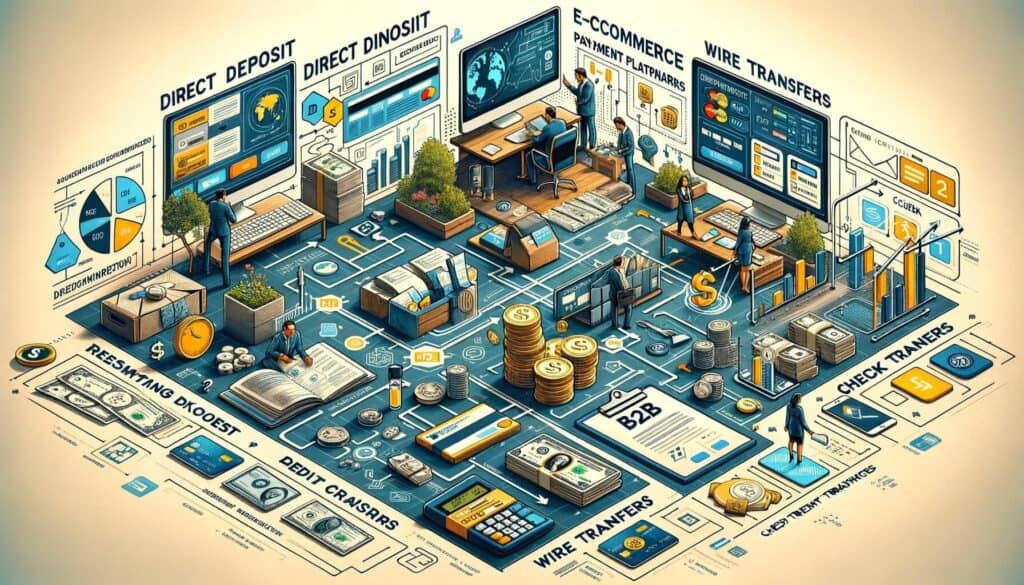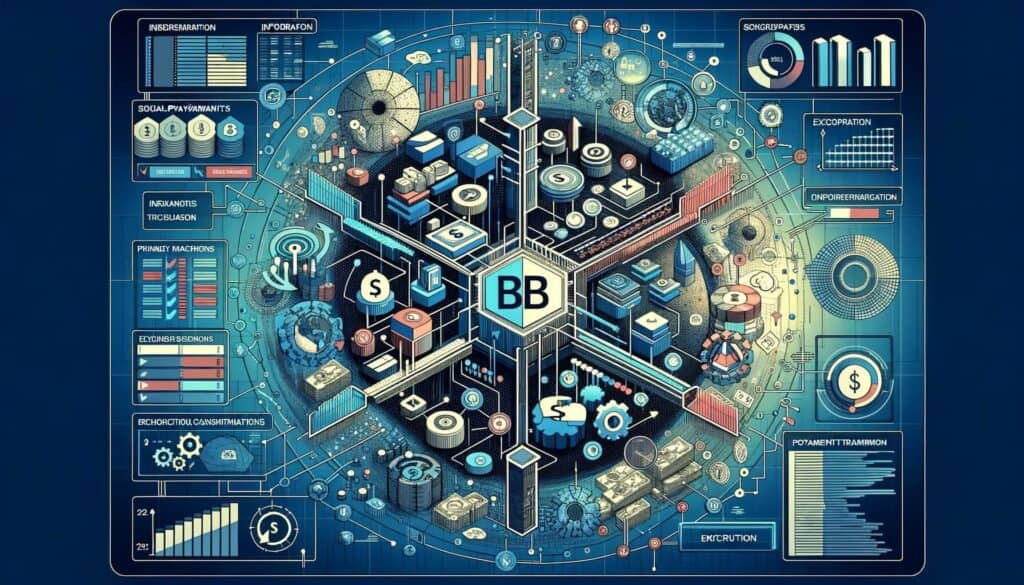
By Carol Peters March 30, 2025
In today’s digital age, businesses are constantly seeking ways to streamline their operations and improve efficiency. One area that often presents challenges is the processing of payments between businesses, commonly known as B2B payments. B2B payments processing refers to the systems and processes involved in facilitating the transfer of funds between businesses for goods or services rendered.
This article will provide a comprehensive overview of B2B payments processing, including its basics, key components, different types of payment methods, implementation steps, choosing the right solution provider, common challenges, best practices, and frequently asked questions.
Understanding the Basics of B2B Payments
B2B payments are fundamentally different from consumer payments, as they involve larger transaction amounts, longer payment terms, and more complex payment processes. Unlike consumer payments, which are typically made using credit cards or online payment platforms, B2B payments often involve invoices, purchase orders, and other documentation. The payment terms can range from 30 to 90 days or even longer, depending on the agreement between the parties involved.
Key Components of B2B Payments Processing

B2B payments processing involves several key components that work together to ensure smooth and efficient payment transactions. These components include invoicing, payment acceptance, payment reconciliation, and reporting. Let’s explore each component in detail:
1. Invoicing: Invoicing is the process of generating and sending an invoice to the buyer, detailing the goods or services provided, the agreed-upon price, and any applicable taxes or fees. Invoices can be generated manually or through automated systems, depending on the volume of transactions.
2. Payment Acceptance: Once the invoice is received by the buyer, they need to initiate the payment process. Payment acceptance methods can vary, including traditional methods such as checks or electronic methods such as bank transfers, Automated Clearing House (ACH) payments, or virtual credit cards.
3. Payment Reconciliation: After the payment is made, the seller needs to reconcile the payment with the corresponding invoice. This involves matching the payment received with the invoice amount and updating the accounting records accordingly. Payment reconciliation can be a time-consuming process, especially for businesses with a high volume of transactions.
4. Reporting: Reporting is an essential component of B2B payments processing as it provides businesses with insights into their payment activities. Reporting can include information such as payment volumes, outstanding invoices, payment trends, and customer payment behavior. This data can help businesses make informed decisions and identify areas for improvement.
Different Types of B2B Payment Methods

There are various payment methods available for B2B transactions, each with its own advantages and considerations. Let’s explore some of the most common types of B2B payment methods:
1. Checks: Despite the rise of digital payment methods, checks remain a popular choice for B2B payments. Checks offer a familiar and tangible form of payment, allowing businesses to maintain a paper trail. However, checks can be time-consuming to process and may involve manual data entry.
2. Bank Transfers: Bank transfers, also known as wire transfers, involve the direct transfer of funds from one bank account to another. Bank transfers are secure and can be processed quickly, making them a preferred choice for high-value transactions. However, they may involve higher fees compared to other payment methods.
3. Automated Clearing House (ACH) Payments: ACH payments are electronic transfers that allow businesses to send and receive funds directly from their bank accounts. ACH payments are cost-effective, secure, and can be automated, making them suitable for recurring payments or large volumes of transactions.
4. Virtual Credit Cards: Virtual credit cards are single-use credit card numbers generated for specific transactions. They offer enhanced security and can be easily integrated into existing payment systems. Virtual credit cards are particularly useful for businesses that require a high level of control and security over their payments.
Implementing B2B Payments Processing: Step-by-Step Guide

Implementing B2B payments processing requires careful planning and consideration. Here is a step-by-step guide to help businesses navigate the implementation process:
1. Assess Current Processes: Start by evaluating your current payment processes, including invoicing, payment acceptance, reconciliation, and reporting. Identify pain points, inefficiencies, and areas for improvement.
2. Set Objectives: Define clear objectives for implementing B2B payments processing. These objectives may include reducing payment processing time, improving cash flow, enhancing security, or increasing automation.
3. Research Solutions: Research and evaluate different B2B payments solution providers. Consider factors such as cost, functionality, integration capabilities, security measures, and customer support. Request demos and gather feedback from other businesses in your industry.
4. Choose a Solution Provider: Select a solution provider that aligns with your business requirements and objectives. Ensure that the provider offers the necessary features, such as invoicing automation, multiple payment acceptance methods, robust reconciliation capabilities, and comprehensive reporting.
5. Plan Integration: Work closely with the solution provider to plan the integration of the B2B payments system with your existing accounting or enterprise resource planning (ERP) software. Consider factors such as data migration, system compatibility, and training requirements.
6. Test and Train: Before fully implementing the B2B payments system, conduct thorough testing to ensure its functionality and compatibility with your existing systems. Train your employees on how to use the new system effectively and address any questions or concerns they may have.
7. Rollout and Monitor: Once the system is implemented, monitor its performance closely. Track key metrics such as payment processing time, cash flow improvement, error rates, and customer satisfaction. Make adjustments as needed to optimize the system’s performance.
Choosing the Right B2B Payments Solution Provider

Selecting the right B2B payments solution provider is crucial for successful implementation and efficient processing. Consider the following factors when choosing a solution provider:
1. Functionality: Ensure that the solution provider offers the necessary features to meet your specific business requirements. This may include features such as automated invoicing, multiple payment acceptance methods, robust reconciliation capabilities, and comprehensive reporting.
2. Integration Capabilities: Check if the solution provider can seamlessly integrate with your existing accounting or ERP software. Integration capabilities are essential for data synchronization, streamlining processes, and avoiding manual data entry.
3. Security Measures: B2B payments involve sensitive financial information, so it’s crucial to choose a solution provider that prioritizes security. Look for providers that offer encryption, tokenization, and other security measures to protect your data and prevent fraud.
4. Cost: Consider the cost of implementing and maintaining the B2B payments system. Evaluate the pricing structure, including any setup fees, transaction fees, or monthly subscription costs. Compare the costs with the expected benefits and ROI to make an informed decision.
5. Customer Support: Reliable customer support is essential when implementing a new system. Ensure that the solution provider offers responsive customer support, including technical assistance, training resources, and ongoing support.
Common Challenges in B2B Payments Processing and How to Overcome Them
Implementing B2B payments processing can come with its fair share of challenges. Here are some common challenges businesses may face and strategies to overcome them:
1. Manual Processes: Many businesses still rely on manual processes for invoicing, payment acceptance, and reconciliation. Manual processes are time-consuming, error-prone, and can lead to delays in payment processing. To overcome this challenge, businesses should consider automating these processes using B2B payments solutions.
2. Lack of Integration: Inefficient integration between payment systems and accounting or ERP software can lead to data discrepancies and manual data entry. To address this challenge, choose a solution provider that offers seamless integration capabilities and work closely with your IT team to ensure a smooth integration process.
3. Payment Fraud: B2B payments are a prime target for fraudsters due to the larger transaction amounts involved. To mitigate the risk of payment fraud, implement robust security measures such as encryption, tokenization, multi-factor authentication, and regular security audits.
4. Late Payments: Late payments can disrupt cash flow and strain business relationships. To encourage timely payments, clearly communicate payment terms and due dates, send reminders, and consider offering incentives for early payments. Implementing automated payment reminders and recurring billing can also help reduce late payments.
5. Complex Payment Reconciliation: Reconciling payments with invoices can be a complex and time-consuming process, especially for businesses with a high volume of transactions. To simplify payment reconciliation, leverage automation tools that can match payments with invoices, flag discrepancies, and update accounting records automatically.
Best Practices for Efficient B2B Payments Processing
To optimize B2B payments processing, businesses should follow these best practices:
1. Streamline Invoicing: Automate the invoicing process to reduce manual errors and improve efficiency. Use templates, standardized formats, and automated reminders to ensure timely and accurate invoicing.
2. Offer Multiple Payment Options: Provide customers with a variety of payment options to accommodate their preferences. This may include traditional methods such as checks and bank transfers, as well as electronic methods such as ACH payments and virtual credit cards.
3. Implement Payment Portals: Payment portals allow customers to view and pay their invoices online, reducing the need for manual data entry and paper-based processes. Payment portals also provide transparency and convenience for customers, improving their overall experience.
4. Leverage Automation: Automate payment acceptance, reconciliation, and reporting processes to reduce manual effort and improve accuracy. Automation can help businesses save time, reduce errors, and improve cash flow management.
5. Monitor and Analyze Payment Data: Regularly monitor payment data and analyze key metrics such as payment volumes, outstanding invoices, and customer payment behavior. This data can provide valuable insights for optimizing payment processes, identifying trends, and making informed business decisions.
Frequently Asked Questions about B2B Payments Processing
Q1. What is the difference between B2B payments and B2C payments?
A1. B2B payments involve transactions between businesses, while B2C payments involve transactions between businesses and consumers. B2B payments typically involve larger transaction amounts, longer payment terms, and more complex payment processes compared to B2C payments.
Q2. What are the advantages of implementing B2B payments processing?
A2. Implementing B2B payments processing offers several advantages, including improved efficiency, faster payment processing, enhanced security, reduced manual effort, better cash flow management, and increased visibility into payment activities.
Q3. How can businesses ensure the security of B2B payments?
A3. Businesses can ensure the security of B2B payments by implementing measures such as encryption, tokenization, multi-factor authentication, regular security audits, and choosing reputable solution providers with robust security protocols.
Q4. What are some common challenges in B2B payments processing?
A4. Common challenges in B2B payments processing include manual processes, lack of integration, payment fraud, late payments, and complex payment reconciliation. These challenges can be overcome by implementing automation, improving integration, enhancing security measures, and streamlining processes.
Q5. How can businesses choose the right B2B payments solution provider?
A5. When choosing a B2B payments solution provider, businesses should consider factors such as functionality, integration capabilities, security measures, cost, and customer support. Request demos, gather feedback from other businesses, and evaluate the provider’s track record and reputation.
Conclusion
B2B payments processing plays a crucial role in facilitating the transfer of funds between businesses. Understanding the basics of B2B payments, including invoicing, payment acceptance, reconciliation, and reporting, is essential for businesses looking to streamline their payment processes.
By implementing the right B2B payments solution and following best practices, businesses can improve efficiency, enhance security, and optimize cash flow management. Overcoming common challenges, such as manual processes, lack of integration, payment fraud, and late payments, requires careful planning, automation, and robust security measures.
By embracing B2B payments processing and leveraging the available tools and technologies, businesses can unlock significant benefits and stay ahead in today’s competitive landscape.
